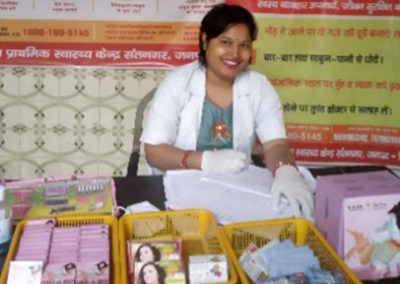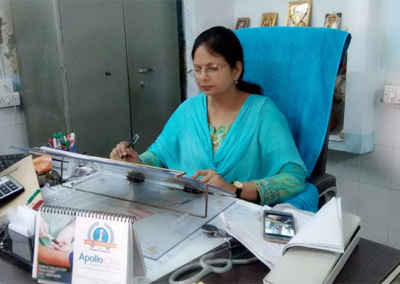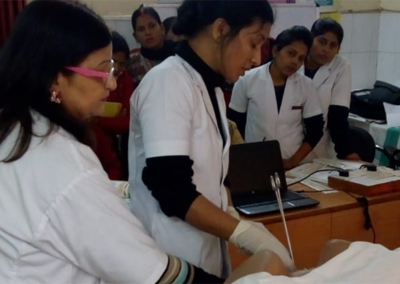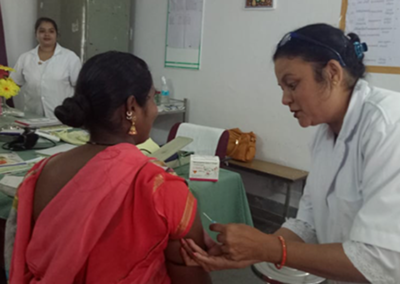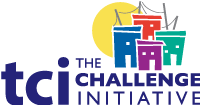India Toolkit: Service Delivery
- Home
- Help and Support
- Close
- Toolkits
- Global Toolkit
- AYSRH Toolkit
- Hub Toolkits
- Core High-Impact Practices
- Gender Essentials Mini Course
- Close
- Resource Collection
- Community of Practice
- Coaching
- Log In/Register
- My Profile
- English
Strengthening the Capacity of Health Service Providers and Health Staff to Deliver Quality Family Planning and AYSRH Services
 Purpose: This tool provides guidance on essential trainings for health service providers and staff of both public and private sector towards improving the quality of family planning (FP) and adolescent and youth sexual and reproductive health services (AYSRH).
Purpose: This tool provides guidance on essential trainings for health service providers and staff of both public and private sector towards improving the quality of family planning (FP) and adolescent and youth sexual and reproductive health services (AYSRH).
Audience:
- Additional Director/Joint Director
- General Manager-FP and Urban (National Health Mission (NHM)
- General Manager Rashtriya Kishore Swasthya Karyakram (RKSK)
- Chief Medical Officers (CMO)/Additional Chief Medical Officers (ACMO)
- Chief Medical Superintendent (CMS)
- Nodal Officers – Urban Health and Family Planning
- Divisional Urban Health Consultant (UHC)
- District Program Manager (DPM)/Urban Health Coordinator (UHC)
- State Quality Assurance Committee (SQAC)/District Quality Assurance Committee (DQAC)
- Medical Officer In-charge (MOIC)/Staff Nurse
- The Federation of Obstetrics and Gynecological (Ob/Gyn) Societies/of India (FOGSI)/District Ob/Gyn Societies/Person In-charge of Private Health Facilities
Background: Training is an opportunity for health care providers to update themselves with techniques and information on contraception. It enables health care providers to seek solutions to day-to-day problems and to improve the quality of services in general. Overall, improving the competencies of health care providers strengthens their skills and knowledge, which has a profound effect on the uptake of contraceptive services and increasing client satisfaction. The following types of competency-based training were found to be effective in strengthening the capacity of the health care providers. The health care providers referred here include the medical and non-medical staff in both government and private facilities.
- Training on Interval Intra Uterine Contraceptive Device (IUCD), Immediate Postpartum and Post-Abortion Intra Uterine Contraceptive Device Insertion (PPIUCD/PAIUCD)
- Training on Injectable Contraceptive
- Training on Centchroman Oral Contraceptive Pill
- Training on Infection Prevention
- Facility Whole Site Orientation
- Training on No-Scalpel Vasectomy
- Training on Minilap and Laparoscopy Female Sterilization
- Refresher Training
Evidence of the Impact
The Challenge Initiative (TCI) India technically supported the government in the capacity building of health care providers. The evidence from various initiatives taken under the TCI project for strengthening the technical and inter-personal capacities of the health care providers contributed to an increase in provider motivation, which resulted in the uptake of FP services and adolescent-friendly services in the project geographies.
In 2017, the Government of India (GoI) expanded the method mix by including two new contraceptive methods—the injectable Antara and non-hormonal weekly pills, Chhaya. The GOI’s guidelines called for a phased rollout of new methods, with the focus in year one being on providing services only to district hospitals. TCI India’s advocacy efforts in the Madhya Pradesh (MP) on increasing access to new contraceptive, resulted in the state government moving an order towards provisioning of the new methods in urban primary health center (UPHCs) by training medical officers and paramedical staff on the new contraceptives. By January 2018, 12 medical officers, 21 staff nurses, and 20 Auxiliary Nurse Midwife (ANMs) were trained in Indore, an intervention city in MP. This increased the uptake of the second dose of Antara to 70% in Indore while the dropout rate at the state level was around 60%. Inspired by the Indore example, other TCI India supported cities gradually increased the uptake of Antara by facilitating training of service providers. (Refer to Most Significant story – Madhya Pradesh’s Expanded Method Mix Brings Injectables to Urban Primary Health Centers)
Similarly, TCI India advocacy efforts in Firozabad, Uttar Pradesh (UP), for leveraging the services of a government contracted agency—the Hindustan Latex Family Planning Promotion Trust (HLFPPT) to train providers in IUCD insertion resulted in the expansion of fixed-day static (FDS) services with IUCDs across all nine UPHCs of the city. Following in the footsteps of Firozabad, the other 17 intervention cities in UP trained 608 providers on IUCD insertion through HLFPPT. (Refer to Most Significant story – TCIHC Advocacy Leads to IUCD Provider Training in Uttar Pradesh UPHCs)
To strengthen AYSRH services in urban, TCI India technically assisted Rashtriya Kishore Swath Karyikram (RKSK) in organizing a WSO for 1260 clinical and non-clinical staff from 96 UPHCs across five intervention cities in UP. The orientation focused on developing health care providers’ competencies in communicating with adolescents and youth about sexual and reproductive health (SRH) issues in a friendly manner. The WSO of facility staff marked improvement in the adolescent health services data uploaded from the 96 UPHCs into the HMIS. A total of 6,369 boys and 10,059 girls were registered for adolescent-friendly health services (AFHS) in the first year of implementation, i.e., from April 2019 to March 2020. In the second year of implementation, from April 2020 to March 2021, this increased by 7% (6,788 boys) and 19% (11,970 girls). Later, TCI India supported government in scaling AFHS to 238 UPHCs in 10 additional cities of UP.
Guidance on Implementing the Trainings
1. On board service providers and assess training needs
Ensure that every urban health facility has service providers who are technically trained on IUCD insertion and removal, injectable contraceptive, and Centchroman Oral Contraceptive Pill services as per Government of India (GoI) standards. All facility staff (primary, secondary, and tertiary) must be trained in infection prevention standards and practices.
Ensure that all staff, particularly male service providers, including staff nurses, pharmacist, lab technicians etc., undergo sensitization and coaching to prioritize and promote FP. While conducting facility assessments, gap analysis exercise (in city consultation workshop), and rapid assessment of public health facilities (for the purpose of developing a city health plan) make sure to assess the current training status and training needs of health care providers.
The development partners like TCI India providing technical support to city government should coordinate with the CMO and district hospital to arrange hands-on training for service providers who have been trained in IUCD, PPIUCD, and PAIUCD but lack clinical practice experience. The training need assessment help in determining the current training gaps and developing training plan. The training need assessment must be conducted annually.
2. Select the type of training to conduct and develop training plan
Select the type of competency-based training to be provided based on the training need assessment findings for strengthening health care providers’ capacity and activating health facilities to provide method-mix services.
Create an annual training calendar or as per requirement, and prior to training arrange following resources: master trainers, a training center, contraceptive commodities and equipment/instruments, consumables, a sufficient number of eligible clients for hands-on practice, training modules of the GoI, educational material, power point presentations, projector, stationary and logistics.
3. Conduct the training activities
Ensure that the health care providers and facility staff should be trained to provide informed choice to eligible FP clients. The following are the specifics of competency-based trainings that are effective in building the capacity of health care providers.
Training on IUCD and PPIUCD/PAIUCD
Many couples who want to keep long term birth spacing opt Long Acting Reversible Contraceptives (LARC) such as IUCD, PPIUCD and PAIUCD. Training all service providers at the district women’s hospitals, medical colleges and community health center can create the necessary technical capacity among nursing personnel (staff nurse, Lady Health Visitor (LHV), ANMs) and doctors (MMBS and above AYUSH) to provide these services. Community volunteers should ensure availability of eligible clients in the training so that the trainee participants could get the opportunity for comprehensive practice.
Duration: Comprehensive 5-days theoretical and practical training at the clinical training site on interval IUCD, PPIUCD and PAIUCD
Content: IUCD, PPIUCD and PAIUCD reference manual (Refer to: IUCD manual for medical officers and nursing personnel; and GoI’s PPIUCD training video)
Audience: Government and private sector doctors and nursing personnel.
Frequency: One-time training; with post-training supportive supervision/ mentoring and refresher as needed
Training on Injectable Contraceptive
To expand the basket of contraceptive choices GoI launched an injectable contraceptive ‘Antara’ in 2017. The availability of Antara services at the UPHCs gave additional choice to women for maintaining space between births. To provide method-mix services, training doctors (MBBS/AYUSH), staff nurses, LHV and ANM on injectable contraceptive technique is essential. According to GoI guideline, training can be imparted by service providers (MBBS and above, AYUSH, Staff Nurses) with prior training experience. The trainer can be designated by Director Family Welfare/State Quality Assurance Committee at state level and by CMO/DQAC at district level. It is mandatory that the first shot of injection be administered under the guidance of a trained MBBS doctor after proper screening. Subsequent shots may be administered by trained AYUSH doctor/staff nurse/LHV/ANM.
Duration: One day
Content: Injectable contraceptive reference manual (Refer to: Reference Manual for Injectable Contraceptive March 2016)
Audience: Government and private sector doctors and nursing personnel.
Frequency: One-time training; with post-training supportive supervision/ mentoring and refresher as needed
Training on Centchroman Oral Contraceptive Pill
In 2017, along with Antara GoI added Chhaya a Centchroman (Ormeloxifene) which is a non-steroidal, non- hormonal weekly oral contraceptive pill in National Family Planning Program to provide method-mix choices to the community. The SQAC/Director Family Welfare at State level and DQAC/CMO at District level can designate trained service providers (MBBS and above, AYUSH, staff nurses) for training Medical Officer (MBBS/AYUSH), staff nurse, LHV and ANM on Chhaya pills.
Duration: One day
Content: Oral contraceptive pills reference manual (Refer to: Reference Manual for Oral Contraceptive Pills March 2016)
Audience: Government and private sector doctors and nursing personnel.
Frequency: One-time training; and refresher as needed
Infection Prevention (IP) Training for Facility Staff
IP is an essential component in the delivery of quality services. Improving quality of care in FP services contributes to the assurance of patient and provider safety, reduction of maternal and new-born morbidity and infections in hospital. Cleanliness and good IP practices are an important element in clients’ satisfaction and their willingness to obtain services. Training on IP is provided to doctors, counsellors, nurses, paramedics and other support staff such as janitor, ward boy/girl etc. to increase their knowledge and skills with respect to IP practices in the facility.
Duration: Half day
Content: Infection Prevention Reference Booklet for Health Care Providers, 2nd Edition, 2011 (Engender Health) and Standards and Quality Assurance in Sterilization Services, Chapter 6, Page no. 53
Audience: Counsellors, medical, paramedical and other support staff in both government and private sector facilities
Frequency: Three monthly or six monthly – Based on assessment, but necessary at the time of staff turnover
Facility Whole Site Orientation (WSO)
WSO are brief sensitization/orientation sessions for counsellors, medical officers, paramedical and non-medical staff at a facility, and are intended to build a FP supportive and gender inclusive environment. For example, PPIUCD decisions are often influenced by janitor, support staff etc. and their sensitization can help support favourable FP decisions. Similarly, non-medical staff have negative perception on the use of contraceptive by unmarried adolescents/youth, through WSO they are oriented to promote an enabling environment for SRH services for unmarried adolescents/youth.
Furthermore, FP should not be limited exclusively to female health staff. Therefore, a change in mind-set is essential, especially among male staff nurses and laboratory technicians, to assist in counseling eligible male clients for FP. The CMO can create a pool of master coaches from the health system to facilitate WSO of clinical and non-clinical staff. These master coaches can be CMS, HODs of medical college, and MOICs.
- WSO of Higher Order Facility Staff on Family Planning
Duration: 2-3 hours, with follow-up refresher trainings as required
Content: TCI India document: Whole-site Family Planning Orientation of High Volume Facility Staff and value clarification on gender and contraceptive use.
Audience: Staff nurse, Counsellors, paramedical staff, pharmacist, lab technician, ward boy/girl, janitor and security staff of both public and private facilities
Frequency: Annually; and refresher as needed
- WSO of Staff on Adolescent-Friendly SRH services
Duration: 2-3 hours, with follow-up refresher trainings as required
Content: TCI India document: Whole-site Orientation for Adolescent Friendly Health Services and value clarification on gender and contraceptive use.
Audience: Staff nurse, ANM, Counsellors, LHV, paramedical staff, pharmacist, lab technician, ward boy/girl, data entry operator, Accredited Social Health Activist (ASHA), janitor and security staff. Clinical and non-clinical staff of private facilities.
Frequency: Annually; and refresher as needed
Training of Surgeons On No-Scalpel Vasectomy (NSV)
NSV method has a strong gender perspective as it encourages males to take responsibility for FP and reducing the additional liability of women. Despite rigorous efforts, there are still not enough NSV users. One reason is that many districts lack sufficient number of NSV surgeons to meet the increase in demand for NSV arising from awareness creation activities for men. Training of MMBS doctors/surgeons who want to learn NSV technique can be organized in government identified training centers. Potential providers can be identified as per GoI guidelines and their names can be recommended through district CMOs, Program Managers and NGOs for training. Community volunteers should ensure availability of beneficiaries in the training so that the trainee participants could get the opportunity for comprehensive practice (Refer to: TCI India FDS tool, for additional guidance).
Duration: 5 days
Content: GoI reference manual for male sterilization (Refer to: Standards & quality assurance in sterilization services, GoI, Nov. 2014)
Audience: Doctors (MBBS and above) of public and private sector
Frequency: One-time training, with concurrent post-training support/ mentoring and refresher as needed
Training of Providers On Minilap and Laparoscopic Female Sterilization (FST)
Increasing the pool of providers trained in laparoscopy and minilap sterilization can help fulfill the increasing demand for these services. The CMO can coordinate with the training centers in their cities, obtain their training calendars and facilitate participation of trainees for FST (Refer to: Gol manual on female sterilization). NGOs can also support by coordinating with the CMOs and other stakeholders to facilitate FST training. Community volunteers should ensure availability of beneficiaries in the training so that the trainee participants could get the opportunity for comprehensive practice. (Refer to: TCI India_FDS tool, for additional guidance).
Duration: 12 days for minilap and laparoscopy
Content: GoI reference manual for female sterilization (Refer to: Standards & quality assurance in sterilization services, GoI, Nov. 2014)
Audience: Doctors (for Minilap – MBBS and above, specialists in other surgical fields; for laparoscopy – MBBS performing minilap sterilization, Post Graduate Diploma or degree in Obstetrics/ Gynecology, specialists in other surgical fields)
Frequency: One-time training, post-training supportive supervision/ mentoring and refresher as needed
Refresher Training
Refresher training on clinical methods is important for providers to have updated knowledge including the contra-indications, technical provisions and management of side-effects and complications of FP methods. Government training centers having necessary infrastructure and adequate clientele can be used as sites for refresher trainings. The trainers can include professors of government medical colleges and other trained and experienced doctors.
Duration: IUCD/ PPIUCD-1 day & FST-3 days
Content: GoI reference manual for female sterilization (Refer to: Standards & quality assurance in sterilization services, GoI, Nov. 2014; Reference manual for IUCD services, Family Planning Division MoHFW, GoI, March 2018)
Audience: Public and Private Sector Doctors (MBBS, PG diploma or degree in obstetrics/ gynecology), Staff nurses for IUCD/PPIUCD
Frequency: One-time training, with post-training supportive supervision/ mentoring
4. Reassess post-training knowledge and provide support
After completing classroom-based training, DQAC committee members must visit facilities to evaluate the service provider’s knowledge and performance on-site. This allows the impact of the training to be assessed, as well as the need for additional mentoring, supportive supervision, and refresher training.
Government officials can assess the needs of trained providers for equipment, supplies and consumables, job aids, technical materials, and other items in MOIC meetings, public-private interface meetings, and facility visits.
Roles and Responsibilities
Training on IUCD and PPIUCD/PAIUCD: Steps to be taken by CMO, CMS, SQAC, DQAC
- Identify doctors and nursing personnel from each facility to travel to the divisional training site for a five-day theoretical and practical training.
- Each trainee is provided theoretical knowledge, has the opportunity to observe procedures and to conduct a minimum of one procedure (1 Interval IUCD insertion, 1 PPIUCD insertion on client under supervision and 1 PAIUCD insertion on client (if available) independently under the supervision prior to certification.
- Ensure that the training is followed by on-site mentoring of trainees by the divisional level trainers as per the standard training plan.
- CMO and CMS to review IUCD/PPIUCD/PAIUCD performance of trained providers at the facility level, sharing experiences and planning for consistent quality of care.
- CMO and NUHM team to ensure availability of IUCD insertion kits and supplies.
- DQAC team to periodically visit facilities to ensure trained service provider are following service provision standards.
Training on Injectable Contraceptive: Steps to be taken by CMO, CMS, SQAC, DQAC
- CMO should conduct follow up within two to three months of completion of training.
- CMO and NUHM team to ensure availability of Antara supplies where trained service providers are available.
- DQAC team to periodically visit facilities to ensure trained service provider are following service provision standards.
Training on Centchroman Oral Contraceptive Pill: Steps to be taken by CMO, CMS, SQAC, DQAC
- CMO should conduct follow up within two to three months of completion of training.
- CMO and NUHM team to ensure availability of Chhaya pills supplies at facilities with trained service providers.
Facility Whole Site Orientation: Steps to be taken by Additional Director and CMO
- Additional Director should leverage the support of WSO master trainers in orienting and sensitizing tertiary, secondary and primary facility staff of other districts/cities of the division.
- CMO to ensure periodically client exit interview is conducted to assess behaviour change in facility staff through client satisfaction level.
Infection Prevention (IP) Training: Steps to be taken by CMO
- Identify a qualified and experienced trainer, either from within or outside the district hospital/ medical college.
- The trainer should first assess the existing IP practices and do a training needs assessment of the facility staff (Refer to: UHI’s Infection Prevention checklist).
- The trainer can utilize the UHI training package to conduct half-a-day training, using PowerPoint presentations, group exercises, pre and post knowledge assessment tools, posters and other necessary materials.
- For any large facility, government or private, an IP committee should be formed which identifies the gaps, develops an action plan and regularly reviews for closure of gaps. For a small facility, a provider can take the responsibility of this function.
- The IP committee, where ever existing, should meet on a monthly basis after the training to assess the progress in improving IP practices according to the action plan, using the assessment checklist. The committee should then decide and implement the necessary corrective actions.
- Learnings on IP should be reinforced from time to time.
- In addition to a classroom training, facility visits by trainers are helpful in observing gaps and encourages practical hands-on-learning.
- To ensure availability of infection prevention equipment and supplies at the facility.
Training of Surgeons on No-Scalpel Vasectomy (NSV): Steps to be taken by CMO
- At district level sufficient number of doctors to be trained to meet the NSV need of the community.
- A follow up post training should be conducted within one to three months.
- To ensure availability of NSV instruments, supplies, job-aids and documents at the NSV service delivery points.
Training of Providers on Minilap and Laparoscopic Female Sterilization (FST): Steps to be taken by CMO
- At district level sufficient number of doctors to be trained to meet the female sterilization need of the community.
- A follow up post training should be conducted within two to three months.
- To ensure availability of FST instruments, supplies, job-aids and documents at the FST service delivery points.
Refresher Training: Steps to be taken by CMO/ACMO
- Identify the number of doctors/staff nurses previously trained on any FP method and assess their performance, so as to identify the need for further refresher training, guidance and support.
- Together with NGO partner, help in identifying empanelled private providers requiring further refresher training, guidance and support
- Nominate such doctors/empanelled private providers and staff nurses for a refresher training
Monitoring and Evaluation of Training Activities
The CMO/CMS and their team should monitor the planning, implementation and outcomes of training activities in the monthly meetings. These activities can also be reviewed in the quarterly DQAC meetings or in the District Health Society (DHS) meetings.
Implementation and outcomes can be monitored using the following indicators after setting the Expected Levels of Achievement (ELA). It would be useful to analyze these indicators separately for public and private facilities and providers.
IUCD/PPIUCD/PAIUCD Insertion Training
- Number of providers trained- segregated list of doctors and nursing personnel
- Increase in the number of IUCD/PPIUCD/PAIUCD insertions performed in facilities over a given time
- Number and percentage of deliveries and abortions followed by PPIUCD and PAIUCD insertion respectively
- Percentage of facilities with at least one provider trained in IUCD/PPIUCD/PAIUCD insertion
Training on Injectable Contraceptive
- Numbers of providers trained in dispensing injectable contraceptive (Antara)
- Percentage of facilities having at least one provider trained in dispensing injectable contraceptive (Antara)
- Increase in the number of injectable cases (dosage wise) at facilities over a given time
Training on Centchroman Oral Contraceptive Pill
- Numbers of providers trained in providing Chhaya services
- Percentage of facilities having at least one provider trained on Chhaya services
- Increase in the number of Chhaya users at facilities over a given time
IP Training
- Number of participants in IP training- segregated list to look for support staff participation
- Percentage knowledge gain post training
- Number of facilities implementing IP training
- Percentage of all facilities conducting IP training
- Number and percentage of facilities having functional IP committees
Facility Whole Site Orientation (WSO)
- Number of orientations planned and organized
- Number of participants of WSO in each facility- segregated list to look for clinical and non-clinical staff participation
- Evidence of increased FP acceptors, post-abortion FP acceptors and post-partum FP acceptors.
- Evidence of increased participation of adolescent and youth in facility adolescent health day at the facilities.
Training of Surgeons for NSV
- Number of surgeons trained in NSV
- Percentage of facilities having at least one provider trained in NSV
- Increase in numbers of NSVs performed at facilities over a given time
Training on Minilap and Laparoscopy (FST)
- Numbers of providers trained in FST (both in Minilap & Laparoscopy)
- Percentage of facilities having at least one provider trained in FST
- Increase in the number of FSTs performed at facilities over a given time
Cost Elements
Training needs to be planned and budgeted separately in the Program Implementation Plan (PIP). This includes the number of activities planned, the number of participants per training and the number of days of training for each activity.
In addition, training of private providers can be budgeted for in the PIP, which requires advocacy with the government at the national, state and district levels.
The table below is indicative and illustrates the manner in which cost elements are provided in a government PIP, thus giving guidance to the audience on where to look for elements related to a particular task, such as capacity building.
| Cost elements/ PIP Budget Head | FMR Code |
| Training on minilap, laparoscopic sterilization, IUCD insertion, PPIUCD insertion, injectable contraceptive for medical officers | Lap induction training &FMR-RCH.6.42.CB.1
Minilap induction training FMR-RCH.6.42.CB.2 |
| Orientation/review of ANM/AWW (as applicable) on: New schemes, FP-LMIS, new contraceptives, post-partum and post-abortion family planning, scheme for home delivery of contraceptives (HDC), ensuring spacing at birth (ESB), wherever applicable, Pregnancy Testing Kits (PTK) |
FMR-RCH.6.50.CB.1.b
|
* Source: NHM PIP Guideline 2022-2024
Sustainability
Linking cost of training to the PIP (PIP resource mobilization tool) is the key to making the training sustainable. The discussion of the planning and monitoring of these activities in the monthly CMO meetings is another important step towards institutionalizing and ensuring sustainability of these capacity-strengthening activities.
TCI APP USERS PLEASE NOTE
You will only receive CERTIFICATES by email – when earning a score above 80% – and will not be able to view or print a certificate PDF from the TCI app.
Test Your Knowledge
Earn a Certificate
Quiz Summary
0 of 5 Questions completed
Questions:
Information
You have already completed the quiz before. Hence you can not start it again.
Quiz is loading…
You must sign in or sign up to start the quiz.
You must first complete the following:
Results
Results
0 of 5 Questions answered correctly
Your time:
Time has elapsed
You have reached 0 of 0 point(s), (0)
Earned Point(s): 0 of 0, (0)
0 Essay(s) Pending (Possible Point(s): 0)
Categories
- Not categorized 0%
- 1
- 2
- 3
- 4
- 5
- Current
- Review
- Answered
- Correct
- Incorrect
-
Question 1 of 5
1. Question
Training providers an opportunity for providers to learn the latest information on Family Planning and seek solutions for day-to-day problems.
CorrectIncorrect -
Question 2 of 5
2. Question
Some examples of training topics include:
CorrectIncorrect -
Question 3 of 5
3. Question
Trainings need to be planned and budgeted separately in the PIP.
CorrectIncorrect -
Question 4 of 5
4. Question
How useful did you find the information and/or tools presented on this page? Please write your response in the box below using one of the following phrases: Very useful, Useful, Somewhat useful, Not useful.
Feel free to comment on why you made that choice.
-
This response will be awarded full points automatically, but it can be reviewed and adjusted after submission.
Grading can be reviewed and adjusted.Grading can be reviewed and adjusted. -
-
Question 5 of 5
5. Question
How do you intend to use the information reviewed and/or tools that you accessed?
-
This response will be awarded full points automatically, but it can be reviewed and adjusted after submission.
Grading can be reviewed and adjusted.Grading can be reviewed and adjusted. -
Service Delivery Approaches
Available Resources
- Clinical Skill Building Guidelines on Male and Female Sterilization
- GoI – PPIUCD Training Video
- Infection Prevention Reference Booklet for Health Care Providers, 2nd Edition, 2011
- Reference manual for IUCD training, family planning division, MOHFW, GoI, Mar 2018
- Operational guidelines on quality assurance in public health facilities – 2013, Sec B, Page No. 1
- Organizational Structure of Operational Guidelines on Quality Assurance
- Reference Manual on Female Sterilization
- Reference Manual on Male Sterilization
- Standards & Quality Assurance in Sterilization Services
- Supreme Court order 2018 for family planning services
- Reference Manual for Injectable Contraceptive 2016
- Reference Manual for Oral Contraceptive Pills 2016
- UHI Infection prevention checklist
- UHI power point presentation on IP
- Whole-site Family Planning Orientation of High Volume Facility Staff
- Whole-site Orientation for Adolescent Friendly Health Services
- Quality Standards of UPHC under NUHM, 2015
- Extension of Kayakalp guidelines in urban areas 2017




